The WE 407-A and WFLI
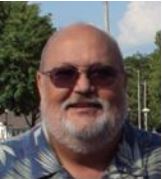
[March 2017] The announcement that WFLI would cease operations on March 31st brings down the curtain on the Benns/Brennan stations – a chain which featured not only home- built transmitters, but well-designed studio and transmitter sites. Each station, from WAPE in Jacksonville, FL to WFLI in Chattanooga, TN, had a personality of its own. Stan Adams visited the station in 2006 and filed this report.
There was a time when a typical 50 kW station was housed in a large building and cared for by a multi-person engineering staff.
For decades, 50 kW stations always were a sort of “breed apart.” Sometimes they were quite literally “flamethrowers,” these were, aside from WLW’s short life at 500 kW, the most powerful stations on the US AM dial. Especially in the pre-solid state days that meant a large group of cabinets, tubes, humming power supplies, roaring fans, and talented engineers to keep everything operating correctly.
In the 1930s and 1940s, these big stations often would invite their listeners to stop by for a tour, so they could see how the “magic” worked in getting their favorite radio programs into their homes. It was hard not to be impressed.
A Classic Transmitter on the Air
In late July of 2006, Dave Hultsman (of Continental Electronics) and I scheduled ourselves for a long weekend in the city of Chattanooga, TN.
After about a half-day’s drive for each of us, we finally were able to accomplish something we had both been talking about for a long time: to see the fully set up Western Electric 407-A4, a 50 kW transmitter at WFLI, in Lookout Mountain, TN.
The WFLI transmitter is probably the last fully-constructed, albeit non-operational, 407-A4 in existence today. The transmitter still was in such good condition when we visited in 2006 that, with the help of a few good engineers, it was entirely possible this behemoth could resume an “on-air” status.
Being the fanatical historians of communication technology that we are, we knew that this would be a unique trip.
Our goal here is to share our visit with you, and show some pictures and manuals we have seen.
A Special Time
To start at the beginning, we must go back to the end of WWII. The country was beginning to “right itself” after a long and arduous war – and the Depression that preceded said war. Many young men and women grabbed hold of the time to set themselves up in business, to see what type of success they could muster.
During these post war years American broadcasting made a huge jump in the number of stations and in the quality of programming.
And while many thought that TV was always threatening the future of radio broadcasting, the fact was TV was so radically different in technology and in financial investment that many of our entrepreneurs found their success in radio.
Special Families
Our history focuses on two families from Birmingham, AL: the Benns’ and Brennan’s.
The Brennan family was a talented group: Bill Brennan was the business man (with a Master’s of Science from Harvard). The other Brennan boys had engineering degrees (except Daniel); Cyril Brennan was a talented and hard working engineer, and Dan Brennan was the voice and programming man of the family.

L to R: Cyril M. Brennan, William “Bill” Brennan, Cyril G. Brennan, and Dan Brennan
Over, on the Benns’ side, it is reported that Ira Lee Benns obtained an engineering degree from Auburn, the first female to so graduate. She was part of the original corporation that filed for and obtained the construction permit for WVOK in Birmingham. Her son William (Billy) obtained a Master’s of Science from Auburn University.
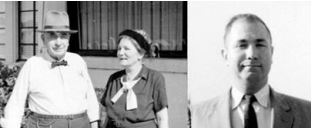
L to R: William Benns Sr. and Ira Lee Benns, and William “Billy” Benns Jr.
It was due to these folks and the hired talents of so many good, dedicated people that this family consortium built own stations from the ground up. Applications, directional arrays, and even building their own towers made this family station group an entirely “in house” group.
A Small Empire
Once this talented group got WVOK operating, then came WBAM in Montgomery, WAPE in Jacksonville, FL, and WFLI in Chattanooga, TN (Dan Brennan applied for a station in Bibb City, Georgia, as well as a couple of TV stations).
These stations had differences in ownership, usually one family or the other, but they shared engineers, air talent, music lists, and whatever else was needed.
In the late 1950’s the FCC’s AM Table of Allocations was modified, allowing stations to apply for regional daytime service on the Class I Clear Channels. As skywave was insignificant in the daytime, by using sophisticated directional systems, stations could be built on these newly allocated channels. The Benns/Brennan combine made their living doing this type of work and owning of stations on such frequencies.
In fact, the only station of this group that started out as a 24-hour station was WFLI, owned by Billy Benns in the Chattanooga/Lookout Mountain area. The other family stations would remain as daytimers, except WAPE, which got night authority fairly rapidly.
The WFLI transmitter pedigree began way back in 1939-40 with WJSV, (later WTOP) Washington, DC as the original owner.
WFLI Is Born
WFLI was Billy’s station. When he received the Construction Permit, Billy was living in the Richmond/DC area, running a station, doing consulting work, and making friends in the general engineering fraternity of the area.
It was during this time (1960-1) that he heard from Clyde Hunt, vice president of engineering for WTOP. After 20 years of service at WTOP, he was replacing the WE 407-A4 with an RCA BTA-50G, and Hunt wanted someone to “come and get the Western Electric Monster and get it out quickly!”
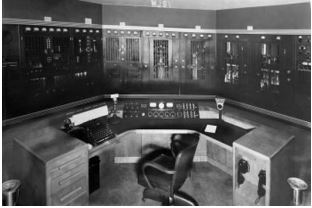
The WE 407-A4 as installed at WTOP (then JSV)
Being the determined fellow that he was, and with a number of personnel from the Benns and Brennan stations, Billy came ready to load and ship something like 12 tons of transmission hardware. Everyone chipped in to help.
Wayne Woollard, a retired engineer who cut his broadcast teeth with WAPE in Jacksonville, was one of the roustabouts called in to disassemble, label, wrap and ship more than a few truckloads of the old WE 407-A4, Serial Number 101 to Chattanooga.
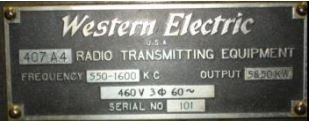
The nameplate from the WTOP transmitter
“Output 5&50 kW”
Wayne Wollard recalls, “I was up there from Jacksonville the first time when they were dynamiting rocks for the guy anchors for the directional. Billy was close to the crew at WTOP and, when they decided to upgrade to another transmitter, Billy bought the WTOP Transmitter, “in Place!” – with the stipulation of getting it out of the building in a very short time.”
It was Billy, Ike Lee of WAPE, and Wayne Wollard who became the trained engineers supervising the dismantling of this extensive transmission system, for a system it was. From power distribution to spare parts, this transmitter was quite a marvel.
WFLI began with 10 kW in the daytime, using the WE 407-A4 in a low plate voltage mode. The evening power of 1 kW was produced by a homemade transmitter.
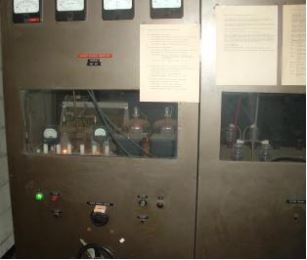
The original, homemade 1 kW WFLI transmitter
Separate directional arrays ultimately allowed 50 kW to be used in the daytime, with a grand 2.5 kW at night.
WE and High Power History
As it is the Western Electric model 407-A4, cast off by WTOP, that is the heart of our story, let us take a closer look at this classic transmitter.
With an early focus on point-to-point transmission of telephony and telegraphic signals, WE had been the prime mover in the design of transmission equipment. It had the backing of Bell Systems and the electrical and electronic support of General Electric and Westinghouse; there was certainly no lack of engineers to tackle the tremendous issues involved with high power transmission systems.
By 1928 WE was able to produce the famous 107-A, 50 kW transmitter, based upon earlier work with transmitters at New Deal Beach, NJ. WLW was the first station in the United States to go up to 50,000 Watts of RF power – taking their WE 106-A and, by adding the high power cabinets, they turned it into the 107-A. Other stations, including KSL, were not far behind in acquiring a 107-A.
If you are keeping score, according to WE’s general numbering scheme, the first digit was the generation, the second and third identified the power level. So the “1” was the first generation of the “07,” or 50,000 Watt model. The “A” meant the transmitter was water-cooled; a “B” transmitter was air-cooled. (There were exceptions: i.e., WJR’s 306-A was a full 50 kW.)
The WE 407-A4
The first station in the country to receive the fourth generation 407-A4 as a complete, new unit was WHAS in Louisville, KY.
In a world where a 50 kW transmitter might be about the size of some refrigerators, it might seem hard to believe the WE 407-A4 required more than 100 square feet of floor space – and the back end of the transmitter was not totally enclosed at that.
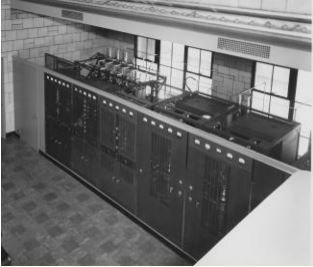
The WE 407-A from above – notice the open back
The testimony from engineers contained in the WE publicity folder of the time indicates that in addition to the power savings the 407-A4, using the newly developed Doherty circuit, was found to be very stable.
WHAS and KSL, which also quickly upgraded to the 407-A4 both found it to be much improved in overall dependability.
Five Cabinets
When laid out, either linearly or in a semi-circle, the WE 407-A transmitter consisted of a total of five cabinets.
The first cabinet contained two of the 702-A quartz oscillator units with the three-stage low RF system and a three stage low level AF system. Rectification shelves were also included in the first cabinet.
The second cabinet was the modulated RF stage. Two 232B water-cooled tubes supplied the modulated 5,000 Watts that formed the basis of excitation to the 50 kW section. At the output of this cabinet, the transmission line could be connected and the transmitter operated at a reduced power level if there were problems sufficient enough to require the elimination of the high-powered circuits.
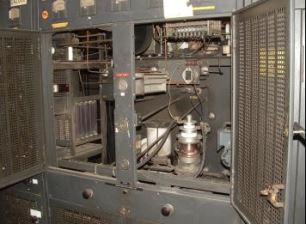
The driver was the current WE 5 kW transmitter
Cabinets three and four contained the carrier and peak power tubes as required for full power Doherty operation. Two 298 water-cooled tubes were used, with a heat dissipation of approximately 85 kWs.
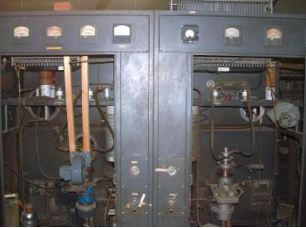
The 407-A4 Carrier and Peak tubes
Cabinet five was a power and control systems cabinet.
However, the full power systems were built in an open arrangement of three divisions.
Feeding the Flamethrower
The AC division consisted of a power control cabinet built by Westinghouse and power transformers designed to operate off of a 460 Volt, three-phase service.
Plate power was regulated by a motor controlled auto transformer with surge protection and supplied a nominal 16 to 18 kV. The second division was in the rear of the lower power stage cabinets and consisted of rectifying elements for the 5 kW driver. A third division was developed around the power needs of the 50 kW stage.
The phasor with the tuning cabinets were a part of external station architecture and not related to the basic cabinet line-ups. Please note the original power tube pictures.
Now, for a little bit of a shocker (pun intended): the total power consumed during programming with average modulation was in the neighborhood of 135 kW. That was some power bill!
A Collins 820-F served as the nighttime and auxiliary transmitter. It is still there on site, just waiting for someone to use it.
Putting it Back Together
When Billy Benns got the 12 tons of cabinets, cooling pipes, and transformers, he moved them from Washington, D.C. to Chattanooga, TN.
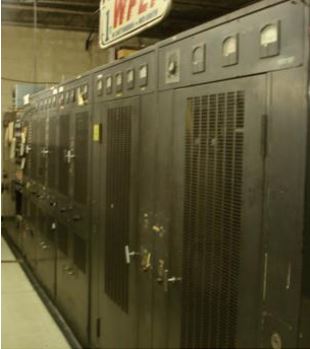
WFLI’s WE 308-A4
As the equipment was installed at WFLI, it was installed as Western Electric would have done. Each cabinet and the external divided power components were properly placed and a custom wiring harness connected all of the appropriate points together.
Underneath the power tubes of the 5 kW driver and the 50 kW cabinet Pyrex tubing that separates the high voltage from coupling into the distilled water supply can still be seen. The three “pole pigs” sit side-by-side on a concrete slab next to the station incoming power transformer where the supplied electricity came to become a 460 Volt delta/wye type of configuration.
There is a December 1992 video documentary, lasting about ten minutes, where Jeff Gregory shows off the 407-A4 transmitter, including the water cooled tubes were still in use at that time.
Real Radio People
Billy was a very skilled owner/engineer but he also had the skills of a very unique Chief, and that was Joe Poteet.
The day-to-day engineer, Joe “Mr. Jet-Fly” (the Top-40 name for the station) Poteet was a competent and able employee of Mr. Benns. In fact, Poteet kept the transmitter operating for many years by making a great number of modifications to keep the transmitter on the air as parts and tubes began to be unavailable after Western Electric stopped making transmitters. He started with the 10 kW/1kW daytime pattern and helped to move to the 50 kW/2.5 kW upgrade.
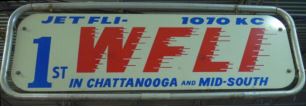
The logo from WFLI’s Rock and Roll days still sits atop the WE 4078-A4 transmitter
As you walk into the station lobby from the outside, there is a framed picture of Joe Poteet, wearing a suit and tie, proudly standing by the transmitter. This is the Joe Poteet that many of the older members of the WFLI staff remember fondly. But the truth be known: we are told his preference was his “bibs.” often wearing them while he worked.
Keeping it Running
Poteet made this station his personal life until he retired about 1992.
As the transmitter was now over 50 years old, it was taking more than the usual care and maintenance. Learning about a 407-A4 being decommissioned in Oklahoma, Poteet arranged for it to be brought and stored in Chattanooga for parts.
Nevertheless, during his last few years working at WFLI – and after retirement on a part-time basis – Poteet helped Jeff Gregory modernize some of the circuits in the old Western Electric and simplify operations. This would add another half-dozen years to this classic transmitter’s life.
For example, the original 298A tubes were changed out to reflect the growing need for reliable replacements, and some overload trip relays were bypassed as being unnecessary. The Machlett 6696A tubes were used to replace the carrier and peak tube in the 50 kW section and additional forced air was added to both power sections of the transmitter.

A Machlett 6696 A Tube
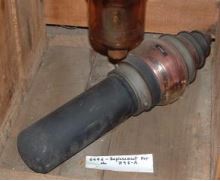
Above, an original 298A tube
A pair of 833A tubes was used to drive a Machlett 6696A water-cooled final in the 5 kW amplifier which, in turn, was easily able to supply the power necessary to drive the high power cabinet.
With the Western Pole Pigs that were provided nominal plate voltage was between 17 kV and 18 kV. Although it was slightly higher than the tube charts recommended, Mr. Brennan found that if the plate voltage was raised to something around 18 kV the tubes would achieve an extra level of efficient operation – and that is how he used these tubes at most of the other stations that were owned by this group.
More Tweaks, More Life
The work of Poteet and Gregory extended the WE 407-A4’s life until Mrs. Ying Benns finally purchased a Harris DX-50.
Jeff tells us that he removed a lot of the mechanical devices such as those for limiting negative peaks so as to simplify the power circuits, allowing the transmitter to just operate without counting on high positive modulation for listenership.
He also modified the old transmitter to help simplify the daily power change procedure and to simplify the fault search when the transmitter would kick off the air.
Basically, Jeff felt that if the “Old Gal” would just gladly sing every morning that he would be content to just allow her to operate as best as she could – and that it was extremely hard when he had to turn the “Old Gal” off for the last time at the age of 58. At last report, while the tubes can be lit, and the fans will come up, the transmitter is not quite what it used to be.
WFLI Today
Over the years the superior engineering and experimentation there had given the programming a solid boost onto the airwaves. Listeners counted on WFLI to serve them from the 1070 spot on the dial right up until March 31, 2017.

While the WE 407-A4 was not currently able to be operational on the air during our visit, Jeff was able to energize the cabinets and “light it up” enough during a station reunion in 2013 to remind folks of how the transmitter looked and sounded when operating during its long life at WFLI.
Mr. Benns, a member of the American Federation of Communication Consulting Engineers, passed away in 1999 at the age of 81.
Korean War veteran and Signal Corps member Joe Poteet passed away in 2003 at the age of 75.
Meanwhile, Jeff Gregory is no slouch in his own right and keeps the station’s DX-50 purring along. We are indebted to Jeff Gregory for much of the story and for his grand attitude in showing us around.
Furthermore, it is to the memory of all good engineers (licensed or not; degreed or not), that the American broadcasting medium owes a debt far beyond payment.
In the end, WFLI ran for 56 years, from 1961 to 2017, until Billy Benns widow and family decided it was time.
One last thought: it is not in the license or the degrees that greatness is found, it is in the willingness to roll up the sleeves, go to work, and to make things happen to benefit of all of mankind.
– – –
We want to thank the late Dave Hultsman for providing some of the pictures. And it bears mentioning that our friend Powell Way desires a well round of thanks for informing us of this transmitter and its location. Without that golden nugget, this story could not be written.
And certainly, without the gracious kindness and time allotted by Jeff Gregory, who is still caring for WFLI’s technical needs, our trip would have been just a bust. Oh, and I did learn that Dave loves Waffle House, it must be the old “road dog” in him.
– – –
Stan Adams is a second generation broadcast engineer in Memphis, TN. You can contact Stan at stanleybadams@gmail.com
